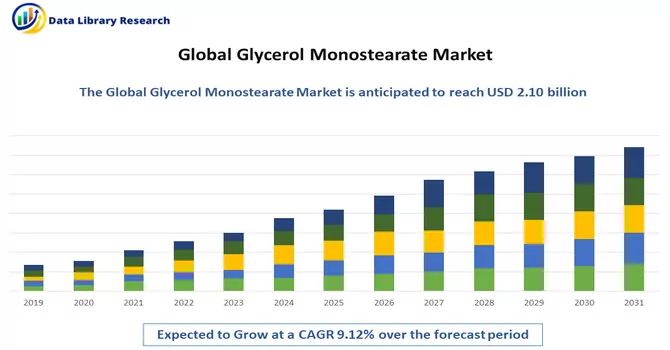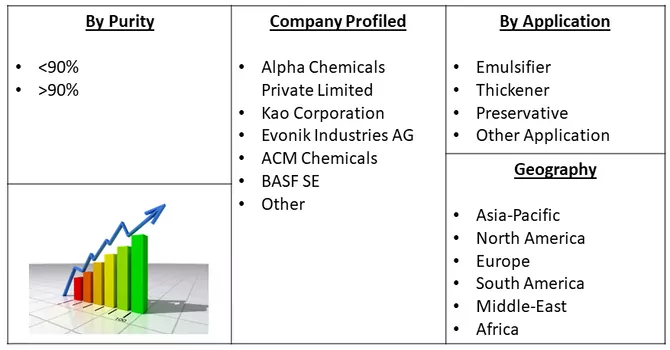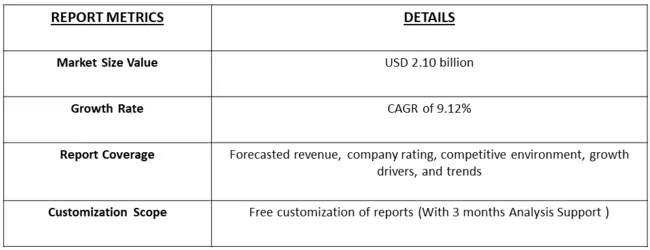The global glycerol monostearate (GMS) market size was estimated at USD 2.10 billion in 2023 and is projected to grow at a compound annual growth rate (CAGR) of 9.12% from 2024 to 2031.

Get Complete Analysis Of The Report - Download Free Sample PDF
Glycerol monostearate (GMS) is a lipid compound consisting of glycerol and stearic acid, classified as a glycerol ester. Commonly utilized as an emulsifier, stabilizer, or thickening agent in various food, cosmetic, and pharmaceutical products, GMS is renowned for its ability to enhance texture, prevent ingredient separation, and improve the overall stability of formulations. As an emulsifying agent, GMS facilitates the blending of water and oil-based components, creating homogeneous mixtures. In the food industry, it is often employed to improve the texture and shelf life of baked goods, dairy products, and confections. GMS is also utilized in the pharmaceutical and cosmetic sectors for its emulsifying and moisturizing properties. As a versatile and multifunctional additive, Glycerol monostearate plays a crucial role in enhancing the quality and consistency of diverse consumer products.
The Glycerol Monostearate (GMS) market is experiencing robust growth driven by several key factors. Increasing consumer demand for food products with improved texture, stability, and shelf life has led to a rising adoption of GMS as a versatile emulsifier and stabilizing agent in the food industry. Additionally, the expanding pharmaceutical and cosmetic sectors are leveraging GMS for its emulsifying and moisturizing properties, contributing to market growth. The growing awareness of GMS as a functional ingredient, coupled with its application in diverse industries, further propels the market. Moreover, as manufacturers prioritize clean label and natural ingredients, GMS, derived from glycerol and stearic acid, aligns with these trends, fostering its widespread incorporation in various products. The escalating demand for processed and convenience foods, along with the expanding applications of GMS in non-food sectors, positions the Glycerol Monostearate market for sustained growth in the foreseeable future.
Market Segmentation: The Glycerol Monostearate Market is Segmented By Purity (<90%, and >90%), Application (Emulsifier, Thickener, Preservative and Other Application), and Geography (North America, Europe, Asia-Pacific, South America, and Africa). The market size and forecast are provided in terms of value (USD million) for the above segments.

For Detailed Market Segmentation - Download Free Sample PDF
The Glycerol Monostearate (GMS) market is experiencing notable trends driven by various factors. The increasing demand for clean-label and natural ingredients in food products is fueling the adoption of GMS as a versatile emulsifier and stabilizer. The growth of the processed food industry, coupled with rising consumer preferences for texture-enhanced and shelf-stable products, is propelling the market forward. In addition to its extensive application in the food industry, GMS is gaining traction in pharmaceuticals and cosmetics due to its emulsifying and moisturizing properties. With manufacturers prioritizing product innovation and functionality, GMS is witnessing expanded applications, contributing to its market growth. Moreover, the market is influenced by the globalization of food and cosmetic trends, leading to a surge in demand for GMS as a key ingredient in various formulations. As sustainability becomes a focal point in the industry, the market is likely to see increased emphasis on eco-friendly and responsibly sourced Glycerol Monostearate, aligning with evolving consumer preferences.
Market Drivers:
The increasing demand for processed and convenience foods
The increasing demand for processed and convenience foods represents a prominent trend in the global food industry, driven by evolving consumer lifestyles and preferences. This demand surge is influenced by factors such as urbanization, a rise in dual-income households, and a fast-paced lifestyle that encourages on-the-go eating. Processed and convenience foods offer consumers the convenience of quick preparation, easy consumption, and extended shelf life, aligning with the demands of modern living. Additionally, the availability of a wide range of ready-to-eat and ready-to-cook options caters to diverse tastes and preferences. Busy schedules, coupled with the desire for time efficiency, have fueled the popularity of these foods, impacting consumption patterns globally. This trend has significant implications for the food industry, influencing product innovation, packaging strategies, and the incorporation of functional ingredients like emulsifiers and stabilizers, such as Glycerol Monostearate (GMS), to enhance texture and stability in processed foods.
The expanding pharmaceutical and cosmetic industries are significant drivers, with GMS finding application in these sectors due to its emulsifying and moisturizing properties
The expanding pharmaceutical and cosmetic industries are witnessing significant growth, and Glycerol Monostearate (GMS) is emerging as a crucial ingredient within these sectors due to its exceptional emulsifying and moisturizing properties. In the pharmaceutical industry, GMS is utilized as an effective emulsifier in the formulation of various medications, enhancing the solubility and bioavailability of active pharmaceutical ingredients. Moreover, its compatibility with both oil and water phases makes it a preferred choice for pharmaceutical formulations. In the cosmetic industry, GMS serves as a versatile emollient and emulsifier, contributing to the stability and texture of creams, lotions, and other skincare products. Its moisturizing properties make it an ideal component for products designed to hydrate and nourish the skin. As both industries continue to expand globally, driven by innovation and consumer demand for high-quality products, GMS is poised to play a pivotal role in meeting formulation challenges and contributing to the efficacy and appeal of pharmaceutical and cosmetic offerings.
Market Restraints:
One notable market restraint for the Glycerol Monostearate (GMS) market is the potential impact of regulatory scrutiny and evolving consumer preferences. Increased awareness of health and wellness, coupled with a growing demand for clean label and natural ingredients, might lead to a shift in consumer choices. Stringent regulations regarding food and cosmetic additives, especially in terms of their origin and production processes, could pose challenges for GMS manufacturers. Adapting to changing regulatory landscapes and aligning with evolving consumer expectations may require substantial adjustments in manufacturing processes and formulations. Additionally, the sustainability and environmental impact of raw materials used in GMS production may become a restraint, as consumers and regulatory bodies increasingly emphasize eco-friendly and responsibly sourced ingredients. Addressing these challenges will be crucial for stakeholders in the GMS market to maintain market share and stay competitive amid evolving market dynamics.
The COVID-19 pandemic has significantly impacted the Glycerol Monostearate (GMS) market, with disruptions observed across various industries. The restrictions on movement, lockdowns, and economic uncertainties during the pandemic have affected the production and supply chains of GMS. The closure of restaurants, hotels, and catering services has led to a decline in demand for processed and convenience foods, impacting the GMS market's application in the food industry. Furthermore, the slowdown in manufacturing and disruptions in logistics have influenced the availability and distribution of GMS, affecting its usage in pharmaceuticals and cosmetics. On the positive side, the increased consumer focus on health and hygiene during the pandemic has driven the demand for personal care and skin care products, providing a partial offset to the market challenges. As industries gradually recover and adapt to the new normal, the Glycerol Monostearate market is expected to witness a resurgence, albeit with considerations for evolving consumer behaviours and supply chain dynamics influenced by the pandemic.
Segmental Analysis:
<90% Segment is Expected to Witness Significant Growth Over the Forecast Period
Glycerol Monostearate (GMS) with a purity level below 90% finds versatile applications across several industries due to its emulsifying, stabilizing, and moisturizing properties. In the food industry, it is commonly used as a food additive and emulsifier, contributing to the texture, stability, and shelf life of various products such as baked goods, dairy items, and confections. In the pharmaceutical sector, GMS serves as a crucial component in medication formulations, acting as an emulsifying agent to enhance drug solubility. Additionally, GMS is widely employed in the cosmetic and personal care industry, featuring prominently in skincare products like creams and lotions due to its moisturizing and emollient characteristics. Its ability to create stable emulsions makes it valuable in the production of cosmetics. The versatile nature of Glycerol Monostearate with a purity below 90% extends its utility to diverse applications, contributing to the formulation and enhancement of products in the food, pharmaceutical, and cosmetic industries.
Emulsifier Segment is Expected to Witness Significant Growth Over the Forecast Period
Emulsifiers play a pivotal role in various industries, and Glycerol Monostearate (GMS) stands out as a key player in the emulsifier market. As an emulsifying agent, GMS facilitates the stable blending of water and oil-based components, preventing separation and ensuring homogeneity in a wide range of products. The GMS market is witnessing robust growth, driven by the increasing demand for processed and convenience foods, where emulsifiers are crucial for achieving the desired texture, consistency, and shelf life. In the pharmaceutical industry, GMS serves as an essential emulsifying agent, enhancing the solubility of active ingredients in medications. Moreover, the cosmetic and personal care industry extensively utilizes GMS as an emollient and stabilizer in the formulation of skincare products. The market's growth is further propelled by the expanding applications of emulsifiers in response to consumer preferences for products with improved sensory attributes and prolonged stability. As industries continue to innovate and evolve, the Emulsifier and Glycerol Monostearate market is poised for sustained growth, driven by the indispensable role of emulsifiers in enhancing the quality and functionality of diverse consumer goods.
North America Segment is Expected to Witness Significant Growth Over the Forecast Period
The North America segment holds a significant position in the Glycerol Monostearate (GMS) market, contributing to its dynamic growth. With a robust presence in industries such as food and beverages, pharmaceuticals, and cosmetics, North America is a key consumer and producer of GMS. In the food industry, GMS is widely utilized as an emulsifying and stabilizing agent, addressing the rising demand for processed and convenience foods in the region. The pharmaceutical sector benefits from GMS as an essential component in medication formulations, aiding in the solubility of pharmaceutical ingredients. Additionally, the cosmetic and personal care industry in North America extensively incorporates GMS in skincare products to enhance emulsion stability and provide moisturizing properties. The region's emphasis on product innovation, coupled with evolving consumer preferences for high-quality and functional ingredients, drives the demand for GMS. The North America segment in the Glycerol Monostearate market is poised for sustained growth, reflecting the pivotal role of GMS in meeting diverse industry needs and aligning with the region's dynamic market trends.

Get Complete Analysis Of The Report - Download Free Sample PDF
The analyzed market exhibits a high degree of fragmentation, primarily attributable to the presence of numerous players operating on both a global and regional scale. The competitive landscape is characterized by a diverse array of companies, each contributing to the overall market dynamics. This fragmentation arises from the existence of specialized solution providers, established industry players, and emerging entrants, all vying for market share. The diversity in market participants is underscored by the adoption of various strategies aimed at expanding the company presence. On a global scale, companies within the studied market are strategically positioning themselves through aggressive expansion initiatives. This often involves entering new geographical regions, targeting untapped markets, and establishing a robust global footprint. The pursuit of global expansion is driven by the recognition of diverse market opportunities and the desire to capitalize on emerging trends and demands across different regions. Simultaneously, at the regional level, companies are tailoring their approaches to align with local market dynamics. Regional players are leveraging their understanding of specific market nuances, regulatory environments, and consumer preferences to gain a competitive edge. This regional focus allows companies to cater to the unique needs of local clientele, fostering stronger market penetration. To navigate the complexities of the fragmented market, companies are implementing a range of strategies. These strategies include investments in research and development to stay at the forefront of technological advancements, mergers and acquisitions to consolidate market share, strategic partnerships for synergies, and innovation to differentiate products and services. The adoption of such multifaceted strategies reflects the competitive nature of the market, with participants continually seeking avenues for growth and sustainability. In essence, the high fragmentation in the studied market not only signifies the diversity of players but also underscores the dynamism and competitiveness that drive ongoing strategic maneuvers. As companies explore various avenues for expansion, the market continues to evolve, presenting both challenges and opportunities for industry stakeholders.
Financials, strategy maps & products of these glycerol monostearate companies are analyzed to map the supply network.
Recent Development:
1) In March 2023, Croda International plc, through its Indian subsidiary Croda India, disclosed a strategic investment of USD 5.4 million for the construction of a new greenfield manufacturing facility in Dahej, Gujarat. This substantial investment is geared towards meeting the escalating demand for pharmaceutical and consumer care products. The state-of-the-art facility is poised to bolster Croda's production capabilities, positioning it strategically in the dynamic market for healthcare and personal care items.
2) In May 2022, Evonik Industries AG inaugurated its cutting-edge Applied Technology Center (ATC) in Sao Paulo, Brazil, marking a significant milestone for the company's Interface & Performance business line. This newly established facility boasts advanced laboratories and two pilot plants, strengthening Evonik's position in the agro-business segment, which includes crucial elements such as emulsifiers, wetting agents, antifoams, and dispersants. Serving as Evonik's third regional Agro Hub, following those in the U.S. and Germany, the ATC in Sao Paulo underscores the company's commitment to innovation and excellence in the agrochemical sector, enhancing its global research and development capabilities.
Q1. What was the Glycerol Monostearate Market size in 2023?
As per Data Library Research the global glycerol monostearate (GMS) market size was estimated at USD 2.10 billion in 2023.
Q2. What is the Growth Rate of the Glycerol Monostearate Market ?
Glycerol Monostearate Market is projected to grow at a compound annual growth rate (CAGR) of 9.12% over the forecast period.
Q3. Which region has the largest share of the Glycerol Monostearate market? What are the largest region's market size and growth rate?
North America has the largest share of the market. For detailed insights on the largest region's market size and growth rate request a sample here.
Q4. Who are the key players in Glycerol Monostearate Market ?
Some key players operating in the market include
Data Library Research are conducted by industry experts who offer insight on industry structure, market segmentations technology assessment and competitive landscape (CL), and penetration, as well as on emerging trends. Their analysis is based on primary interviews (~ 80%) and secondary research (~ 20%) as well as years of professional expertise in their respective industries. Adding to this, by analysing historical trends and current market positions, our analysts predict where the market will be headed for the next five years. Furthermore, the varying trends of segment & categories geographically presented are also studied and the estimated based on the primary & secondary research.
In this particular report from the supply side Data Library Research has conducted primary surveys (interviews) with the key level executives (VP, CEO’s, Marketing Director, Business Development Manager and SOFT) of the companies that active & prominent as well as the midsized organization
FIGURE 1: DLR RESEARH PROCESS

Extensive primary research was conducted to gain a deeper insight of the market and industry performance. The analysis is based on both primary and secondary research as well as years of professional expertise in the respective industries.
In addition to analysing current and historical trends, our analysts predict where the market is headed over the next five years.
It varies by segment for these categories geographically presented in the list of market tables. Speaking about this particular report we have conducted primary surveys (interviews) with the key level executives (VP, CEO’s, Marketing Director, Business Development Manager and many more) of the major players active in the market.
Secondary ResearchSecondary research was mainly used to collect and identify information useful for the extensive, technical, market-oriented, and Friend’s study of the Global Extra Neutral Alcohol. It was also used to obtain key information about major players, market classification and segmentation according to the industry trends, geographical markets, and developments related to the market and technology perspectives. For this study, analysts have gathered information from various credible sources, such as annual reports, sec filings, journals, white papers, SOFT presentations, and company web sites.
Market Size EstimationBoth, top-down and bottom-up approaches were used to estimate and validate the size of the Global market and to estimate the size of various other dependent submarkets in the overall Extra Neutral Alcohol. The key players in the market were identified through secondary research and their market contributions in the respective geographies were determined through primary and secondary research.
Forecast Model
